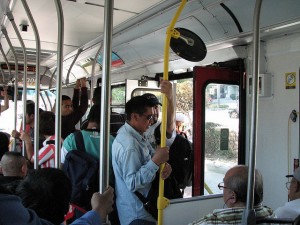 Transit ridership is falling across the country, while driving miles are up. Much of the change is probably due to a relatively strong economy and low gas prices, plus the impact of venture capital-subsidized rideshare companies like Uber and Lyft.
Transit ridership is falling across the country, while driving miles are up. Much of the change is probably due to a relatively strong economy and low gas prices, plus the impact of venture capital-subsidized rideshare companies like Uber and Lyft.
But what about poor transit service, particularly on buses? The ridership decline provides opportunities for transit agencies to rethink their bus systems. But it may not be enough.
Governing.com profiles Columbus, Ohio’s recent efforts on this front:
The Columbus transit agency spent four years and $9.4 million studying its bus network, gathering public feedback and designing alternative routes. All of that work came to a head this May, when COTA switched to a completely new system. It doubled the number of bus lines with frequent service (every 15 minutes or less), deploying many of them along major roads far from downtown. The new routes added or increased service to the airport, shopping malls, a casino and many other job centers. By COTA’s estimate, the number of jobs within a quarter mile (a five-minute walk) of a frequent bus line jumped from 155,000 to 265,000. The number of people who lived within a quarter mile of those lines increased from 116,000 to 219,000. Plus, the agency beefed up service on Saturdays and Sundays. And Columbus did all of it without an increase in funding.
It remains to be seen how effective this redesign will be.
Meanwhile, pre-Hurricane Harvey Houston also redesigned its bus network in the past few years, adding $12 million to the operating budget. But the results were mixed-to-disappointing: ridership increased 6.8 percent in the first year, with most though from increased light rail trips and 1.2 percent from bus trips (weekday trips decreased). Ridership during the second year was flat.
So if a redesign is not enough, what needs to be done? Three things:
- Build more bus-only lanes and bus rapid transit lines. If buses can avoid traffic and beat car travel times, ridership will surge.
- Build more housing and jobs around high-traffic bus corridors (and stop building automobile infrastructure in these areas). The more people living and working near bus lines will boost ridership. And the more cars are not accommodated, such as through locally mandated parking spaces or garages, the faster bus service will be.
- Lower fares. History has shown that lowering fares is a good way to attract more riders. The fare decreases could be paid for by congestion pricing on automobile traffic in key corridors during peak commute times. It’s a double-win: less automobile traffic, more bus ridership.
All of these solutions will require policy action and investment, which means political will to get it done. It’s harder than a bus redesign but will ultimately provide a lasting solution to the ridership challenges.


